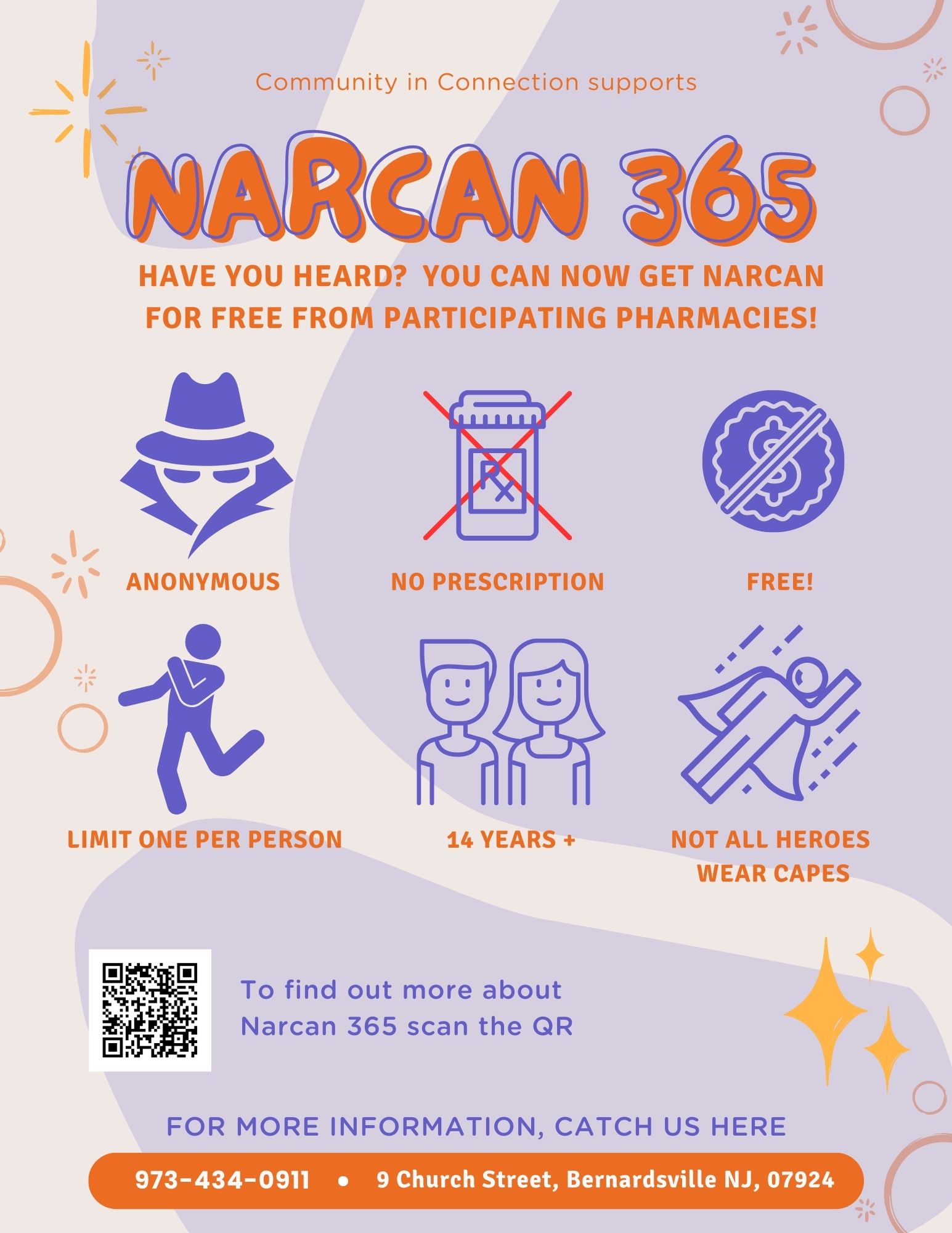
Call 911 immediately!
New Jersey law protects people calling for help.
What does Harm Reduction mean?
“Harm reduction is a set of ideas and interventions that seek to reduce the harms associated with both drug use and ineffective, racialize drug policies.
Harm reduction stands in stark contrast to a punitive approach to problematic drug use—it is based on acknowledging the dignity and humanity of people who use drugs and bringing them into a community of care in order to minimize negative consequences and promote optimal health and social inclusion.” – Drug Policy Alliance
There is so much to learn...
When we arm ourselves with knowledge, we can be united in preventing unnecessary overdose deaths. Adopting harm reduction principles is something we already do everyday – seat belts are harm reduction! Become a harm reduction messenger. It’s easier than you think.
want to learn more?
Signs of an overdose include:
- The person is unconscious and you can’t wake them.
- Breathing slowly or not at all.
- Lips and nails are turning blue.
- Inability to talk.
- Snoring or gurgling sounds.
- Small pupils.
What to do if someone overdoses:
- Call 911 immediately!
- Say “I think someone may have overdosed. (S)he isn’t breathing.”
- If the person is not breathing, do rescue breathing (mouth-to-mouth).
- Give Narcan/naloxone (the opioid overdose reversal drug) to the person if you have it.
- Lay the person on their side once they resume breathing.
The difference between life and death can be a matter of minutes. How you react could save a life. Please see the below resources that will help you to identify the signs, what to do in the event of an overdose, what is Naloxone(AKA Narcan) and recent updates in response to COVID-19. Also learn about Good Samaritan Laws that provides legal immunity without fear of arrest for a victim of overdose or a witness of overdose when they call 911.
What is NARCAN:
- NARCAN is a brand name of the life saving drug naloxone.
- Proper administration and storage.
- NARCAN is not a substitute for emergency medical care. Always get help immediately, even if the person wakes up, because he/she may relapse into respiratory depression.
Dangers of fentanyl
More than 100,000 people in the U.S. have died from an overdose in the past year and it’s driven by one drug – fentanyl.
Fentanyl is a synthetic drug 50 times more potent than heroin and 100 times more potent than morphine.
Spread the word about the dangers of fentanyl. Learn the signs of an overdose so you can identify if someone might need Narcan.
GETTING OVER-THE-COUNTER AND PRESCRIPTION NARCAN IS EASY! HERE’S HOW.
Xylazine is being mixed with fentanyl.
Xylazine, a non-opioid veterinary tranquilizer not approved for human use. It has been linked to an increasing number of overdose deaths nationwide and often unknowingly used in combination with other drugs, particularly fentanyl.
Tips on Xylazine:
- Start low, go slow. It stays in the body for hours so doses can pile up, your high may last longer. Try no tto use alone and be extra careful if you take clonidine.
- Use naloxone (Narcan) & call for help.
- Naloxone will treat fentanyl overdose but not xylazine. If somebody isn’t waking up with naloxone they may need other medications to save their life.
- Check your skin. People who use xylazine may get more wounds, even in spots they don’t inject. Care for wounds early.
NJ COVID-19 response to prescription pain killers and naloxone.
TRENTON – Under an Administrative Order issued today, prescribers must co-prescribe naloxone to any patient continuously receiving opioids for chronic pain management if the patient has one or more prescriptions totaling 90 morphine milligram equivalents (MME) or more per day, or is concurrently taking an opioid and a benzodiazepine. These patients face heightened risk of a fatal overdose. (May 21, 2020)

Resources for People Who Use Drugs
For individuals struggling with drug use, there are various essential help resources available to provide support and aid in their journey towards recovery. Local and national organizations, such as substance abuse hotlines and crisis centers, offer immediate assistance and guidance for those in need.
- FREE Narcan: Get Naloxone – NJ Harm Reduction Coalition
- NJ Harm Reduction Coalition Meetings: Find one HERE.
- Harm Reduction Works: Learn more HERE.
- Never Use Alone Hotline: Peer led. 24-hours a day, 7 days a week, 365 days a year. Call 800-484-3731
If you decide to use, protect yourself.
PWUD can protect themselves with some or all of the following measures:
- PACE: Start low and go slow. Gauge potency and effects of a substance before considering higher doses. Get Naloxone – NJ Harm Reduction Coalition
- REMIND: Stay hydrated and remember to eat.
- ORGANIZE: Make sure all equipment is sterile and properly disposed of. Find a free syringe access program near you.
- TEST: Order a test kit and use it every time.
- EMPOWER: Understand the inherent risks involved with substance use and learn how to avoid some of the negative impacts.
- COORDINATE: Never use alone and keep Narcan on hand. Alternatively, Utilize the never use alone phone number.
- TALK: You are not alone. Harm reduction is always available to you and can help you mitigate the risks associated with substance use.

Did you know about NJ's Good Samaritan Law?
The New Jersey Good Samaritan statute, titled the Overdose Prevention Act, encourages and protects bystanders, including doctors and paramedics, at an accident scene to render assistance to someone in need without fear of being sued if things go wrong. More specifically, it states in part:
“A person who, in good faith, seeks medical assistance for someone experiencing a drug overdose shall not be: arrested, charged, prosecuted, or convicted for obtaining, possessing, using, or being under the influence of a controlled dangerous substance.”


